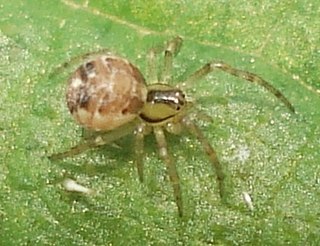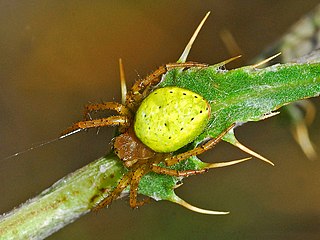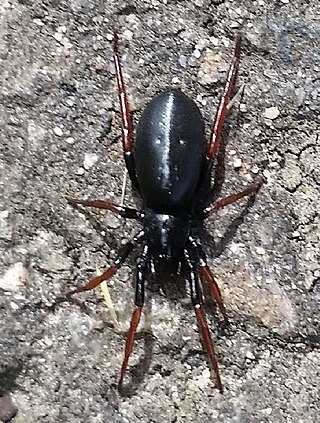
Phoneutria is a genus of spiders in the family Ctenidae. They are mainly found in northern South America, with one species in Central America. Members of the genus are commonly referred to as Brazilian wandering spiders. Other English names include armed spiders and banana spiders.

Argiope catenulata, also known as the grass cross spider, is a species of orb-weaver spider ranging from India to the Philippines and Papua New Guinea, and also found in Australia in 2019. Like other species of the same genus, it builds a web with a zig-zag stabilimentum.

Agalenatea redii is a species of 'orbweavers' belonging to the family Araneidae subfamily Araneinae.

Carrhotus xanthogramma is a species of jumping spider belonging to the family Salticidae.
Zodarion granulatum is a spider species found in Cyprus, Greece, Turkey, Lebanon, and Israel.
Antrodiaetus microunicolor is a species of antrodiaetid mygalomorph spider. It is found in the United States of America.

Phylloneta impressa is a species of comb-footed spider from the genus Phylloneta with a Holarctic distribution.
Cryphoeca silvicola is a small species of dwarf sheet spider in the family Cybaeidae which has a Palearctic distribution. The generic name, Cryphoeca, means hidden and the specific name silvicola means "living in the woods".

Tetragnatha montana, commonly known as the silver stretch spider, is a species of long-jawed orb weaver from the family Tetragnathidae that has a Palearctic distribution. It preys mostly on flies and mosquitoes. The name silver stretch spider refers to its shiny metallic colour and its habit of extending its legs into a stick like shape.
Carpathonesticus puteorum is a species of araneomorph spider of the family Nesticidae. It is found in the Romanian caves at an altitude of 460 to 930 m.
Carpathonesticus parvus is a species of araneomorph spider of the family Nesticidae. It occurs in Bosnia-Hercegovina, where it is found in caves. It was originally described from a single female specimen.
Carpathonesticus spelaeus is an araneomorph spider species of the family Nesticidae. It is found in Romania, where it can be found in caves and outdoors under calcareous blocks. It was transferred from the genus Nesticus to Carpathonesticus in 1980 by Lehtinen and Saaristo.

Euophrys kawkaban is a species of jumping spider in the genus Euophrys that is endemic to Yemen. The species was first described in 2007 by Wanda Wesołowska and Antonius van Harten. It is a very small spider, with a body that consists of a carapace, the hard upper part of the cephalothorax, that is typically 1.7 mm (0.07 in) long and 1.3 mm (0.05 in) wide and an abdomen that is typically 1.5 mm (0.06 in) long and 1.1 mm (0.04 in) wide. The carapace is yellowish, marked with a pattern of brown wedges, with a dark brown eye field. The underside of the cephalothorax, or sternum, is yellowish-brown. The abdomen has a pattern of yellowish-white and brownish-black spots that, at times, look like a series of waves. The spider's clypeus is unusual, being yellowish-brown with a covering of white hairs, which clearly differentiates the species from the related Euophrys flavoater. The male's copulatory organs, including its long and thin embolus, also helps distinguish the species. The female has not been described.
Chrysilla guineensis is a species of jumping spider. It is endemic to Guinea. It was described in 2013 based on specimens collected from the Nimba Mountains.
Diminutella is a genus of spiders in the family Sparassidae. It was first described in 2018 by Rheims and Alayón. It is a monotypic genus with one described species, Diminutella cortina. It is endemic to Pinar del Rio, Cuba.

Araniella opisthographa is a species of orb weaver in the spider family Araneidae.

Araneus grossus is a orb-weaver spider species. The species is one of the largest orb-weaver spiders in Europe. It is found in South and Southeast Europe and Central Asia.
Phoneutria depilata is a species of spider in the family Ctenidae, found in Central America.

Trachyzelotes pedestris, The yellow-legged zipper spider, is a species of Trachyzelotes ground spider first described by C.L.Koch in 1837.

Phrurolithus festivus is a spider in the family Phrurolithidae. It was originally distributed only in the Palaearctic and was introduced into Canada. The highly adaptable species inhabits a variety of both dry and wet habitats and can also be found in man-made habitats, but generally prefers open areas.











